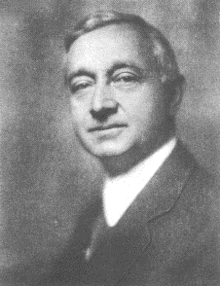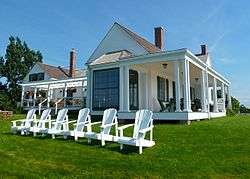Cyrus S. Eaton
| Cyrus Eaton | |
|---|---|
 | |
| Born |
Cyrus Stephen Eaton December 27, 1883 Cumberland County, Nova Scotia, Canada |
| Died |
May 9, 1979 (aged 95) Cleveland, Ohio, USA; buried: Deep Cove, Nova Scotia, Canada |
| Nationality | Canadian |
| Occupation | Businessman |
Cyrus Stephen Eaton, Sr. (December 27, 1883 – May 9, 1979) was a Canadian-American investment banker, businessman and philanthropist, with a career that spanned seventy years.[1][2]
For decades Eaton was one of the most powerful financiers in the American Midwest, and he was a colourful and often-controversial figure.[3][4] He was chiefly known for his longevity in business, for his opposition to the dominance of eastern financiers in the America of his day, for his occasionally ruthless financial manipulations, for his passion for world peace and for his outspoken criticism of United States Cold War policy. He funded and helped organize the first Pugwash Conferences on World Peace, in 1955.[3] He wrote numerous articles and essays on political and economic subjects—"Investment Banking", "Competition or Decadence", "Rationalism Versus Rockefeller", and "A Capitalist Looks at Labour" being some of the best known.[5]
Biography
Eaton was born on December 27, 1883 on a farm near the village of Pugwash in Cumberland County, Nova Scotia, Canada.[3] Besides farming, his father, Joseph Howe Eaton, ran a small general store and the district post office.[3] Cyrus' uncle was Charles Aubrey Eaton.
Eaton left Nova Scotia in 1899 to attend Woodstock College, a Baptist-affiliated prep school in Woodstock, Ontario. He then enrolled at McMaster University, a Baptist university in Hamilton, Ontario, in 1901, where he studied philosophy and finance, intending to enter the Baptist ministry.[3] He earned his bachelor of arts degree in 1905 with a major in philosophy.[3]

After graduating from McMaster he moved to Cleveland and went to work for the East Ohio Gas Company. This was one of many businesses associated with John D. Rockefeller. After working with Ohio Gas and Rockefeller for two years, he established his own business in 1907, developing gas utilities which at the time were relatively underdeveloped and unconsolidated in Canada. He managed to secure natural-gas franchises in Manitoba, Canada representing a group of New York investors. The syndicate was not able to complete its financing and folded. However, the Manitoba government was sufficiently impressed to allow Eaton to retain the franchises. Eaton formed a new holding company, the Canada Gas & Electric Corp, later consolidated into the Continental Gas & Electric Corp. in 1913.
After spending several years traveling, Eaton settled in Cleveland in 1913 and became active in many businesses. Eaton joined the Otis & Co. banking firm in 1916. In 1926 he set up an investment vehicle organized as Continental Shares, Inc., a closed end trust. In 1927 he formed Republic Steel, the 3rd-largest U.S. steel company. His business had a complex structure which some felt to be too highly leveraged. His 1929 wealth was an estimated $100 million, most of which was lost in the Great Depression.
Eaton rebuilt his fortune in the 1940s and 1950s, becoming a director (1943), then board chairman (1954), of the Chesapeake and Ohio Railway; and also board chairman of the West Kentucky Coal Co. (1953).[4]
He died on May 9, 1979 at his home, Acadia Farm, near Cleveland, Ohio.[1][2]
Philanthropy

In 1920, Eaton founded the Cleveland Museum of Natural History.[4]
The Russell–Einstein Manifesto was issued in London on July 9, 1955 by Bertrand Russell in the midst of the Cold War. It highlighted the dangers posed by nuclear weapons and called for world leaders to seek peaceful resolutions to international conflict. The signatories included eleven preeminent intellectuals and scientists, including Albert Einstein, who signed it just days before his death on April 18, 1955. A few days after the release, philanthropist Eaton offered to sponsor a conference—called for in the manifesto—in Pugwash, Nova Scotia, Eaton's birthplace. This conference was to be the first of the Pugwash Conferences on Science and World Affairs, held in July 1957.
Besides financial support for the Pugwash Conferences, Eaton gave money to support education in Nova Scotia, particularly in Pugwash and to Acadia University. He supported the establishment of a game sanctuary in Nova Scotia on the Aspotogan Peninsula (his summer home was in Blandford, Nova Scotia where he had his ashes buried. He donated money for the doors of St. Bartholmus Church in Blandford and 12 acres (4.9 hectares) of land in Northfield, Ohio, for the Lee Eaton Elementary School, named in memory of his daughter. He was also a financial supporter of McMaster University, the YWCA, the Cleveland Museum of Natural History and Case Western Reserve University. At his death in 1979, his Blandford estate was purchased by a group of businessmen from Germany. His summer home was destroyed in a fire 2015.
Awards

Eaton's 1950s efforts at rapprochement with the Soviet Union won him the 1960 Lenin Peace Prize. He was elected a fellow of the American Academy of Arts and Sciences in 1958, and was the recipient of an honorary degree from Bowling Green State University in 1969. The Pugwash Conferences and their chairman, Joseph Rotblat, were awarded the Nobel Peace Prize in 1995.
Eaton married twice; first, in 1907, Margaret House; then Anne Kinder Jones in 1957. He had seven children: Margaret Grace, Mary Adelle, Elizabeth Ann, Anna Bishop, Cyrus S. Jr., Augusta Farlee, and MacPherson. He died in Ohio and had his ashes buried in Blandford, Nova Scotia.
Legacy
- Cyrus Eaton Elementary School, Pugwash, Nova Scotia
- Cyrus Eaton Elementary School, Truro, Nova Scotia
References
- 1 2 Alden Whitman (May 11, 1979). "Cyrus Eaton, Industrialist, 95, Dies. Cyrus Eaton Dies at 95. Cleveland Industrialist Urged Links With Communists". New York Times. Retrieved 2014-12-15.
Cyrus S. Eaton Sr., a multimillionaire industrialist who strongly advocated friendly relations with the Communist world, died Wednesday night at his home, Acadia Farm, near Cleveland. He was 95 years old. ...
- 1 2 United Press International. "Industrialist Cyrus Eaton Dead at 95". The Milwaukee Sentinel. Retrieved 2014-12-15.
- 1 2 3 4 5 6 Eaton biography
- 1 2 3 http://ech.case.edu/cgi/article.pl?id=ECS1
- ↑ http://speeches.empireclub.org/60606/data
External links
- "Book of Members, 1780-2010: Chapter E". American Academy of Arts and Sciences. Retrieved 7 April 2011
- Cyrus Eaton interviewed by Mike Wallace on The Mike Wallace Interview
Further reading
- Gleiser, Marcus, The World of Cyrus Eaton Kent State University Press, 2010; a biography, first published in 1966.
- Gibson, M. Allen, Beautiful Upon the Mountain: A portrait of Cyrus Eaton Lancelot Press, Windsor, Nova Scotia, 1977.
- Time Magazine Cover story. Feb. 24, 1930.